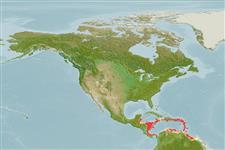Environment: milieu / climate zone / depth range / distribution range
Écologie
marin récifal; profondeur 0 - 66 m (Ref. 9710). Subtropical; 19°N - 1°S, 89°W - 48°W (Ref. 55171)
Western Atlantic: Bermuda, Florida Keys (USA), Gulf of Mexico, Bahamas; Greater Antilles (including Cuba, Hispanola, Puerto Rico, Jamaica and Cayman Is.), Virgin Is.; Lesser Antilles (island chain south of the British Virgin Islands to Grenada); western Caribbean (ne tip of the Yucatan Peninsula to Colombia, including offshore islands; northern South America (region north of Amazon River including Trinidad and Tobago and off coasts of Colombia, Venezuela. Eastern Atlantic: Ascension Island.
Taille / Poids / Âge
Maturity: Lm ? range ? - ? cm
Max length : 20.0 cm TL mâle / non sexé; (Ref. 7251)
Description synthétique
Morphologie | Morphométrie
Rayons mous dorsaux (Total): 11-12; Rayons mous anaux: 6 - 7. Illicium about twice as long as second dorsal spine (Ref. 26938).
Inhabit shallow reefs (Ref. 9710). Commonly found in areas with sponges; background hue of the fish conforms to that of the dominant sponge in the areas and the ocelli look like openings in the sponge. Feed mainly on fishes, but also eat crustaceans (Ref. 13442). A voracious predator, with many color phases used for camouflage. Oviparous (Ref. 205). Eggs are bound in ribbon-like sheath or mass of gelatinous mucus called 'egg raft' or 'veil' (Ref. 6773). Most common frogfish in the West Indies (Ref. 26938).
Life cycle and mating behavior
Maturité | Reproduction | Frai | Œufs | Fécondité | Larves
Oviparous.
Robins, C.R. and G.C. Ray, 1986. A field guide to Atlantic coast fishes of North America. Houghton Mifflin Company, Boston, U.S.A. 354 p. (Ref. 7251)
Statut dans la liste rouge de l'IUCN (Ref. 130435)
Menace pour l'homme
Harmless
Utilisations par l'homme
Pêcheries: pêcheries vivrières; Aquarium: Commercial
Plus d'informations
Taille/ÂgeCroissanceLongueur-poidsLongueur-longueurFréquences de longueursMorphométrieMorphologieLarvesDynamique des populations larvairesRecrutementAbondanceBRUVS
RéférencesAquacultureProfil d'aquacultureSouchesGénétiqueElectrophoresesHéritabilitéPathologiesTraitementNutrientsMass conversion
CollaborateursImagesStamps, Coins Misc.SonsCiguateraVitesseType de nageSurface branchialeOtolithesCerveauxVision
Outils
Articles particuliers
Télécharger en XML
Sources Internet
Estimates based on models
Preferred temperature (Ref.
123201): 27.1 - 28.3, mean 27.8 °C (based on 78 cells).
Phylogenetic diversity index (Ref.
82804): PD
50 = 0.5005 [Uniqueness, from 0.5 = low to 2.0 = high].
Bayesian length-weight: a=0.01995 (0.00906 - 0.04395), b=3.01 (2.83 - 3.19), in cm total length, based on all LWR estimates for this body shape (Ref.
93245).
Niveau trophique (Ref.
69278): 4.3 ±0.7 se; based on diet studies.
Résilience (Ref.
120179): Haut, temps minimum de doublement de population inférieur à 15 mois (Fec assumed to be > 10,000).
Fishing Vulnerability (Ref.
59153): Low vulnerability (10 of 100).
Nutrients (Ref.
124155): Calcium = 33.2 [14.6, 80.1] mg/100g; Iron = 0.619 [0.309, 1.196] mg/100g; Protein = 19.5 [17.0, 22.7] %; Omega3 = 0.182 [0.066, 0.484] g/100g; Selenium = 12.3 [4.9, 32.9] μg/100g; VitaminA = 114 [27, 508] μg/100g; Zinc = 0.686 [0.399, 1.116] mg/100g (wet weight);
